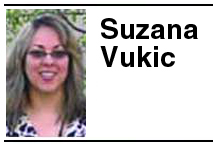By Suzana Vukic
Suzana Vukic is a freelance journalist, columnist and writer from Montreal, Canada, who reports extensively on the Balkans. She is also a member of the International Expert Team of the Institute for the Research of Genocide Canada.
Before heading to Bosnia and the Srebrenica Peace March, I discussed the trip with Hudson resident Vivianne LaRiviere, who described it as a pilgrimage. I agreed that for me, the Srebrenica Peace March had the essential characteristics of a pilgrimage.
Having completed the Srebrenica Peace March from start to finish, I feel there is no greater pilgrimage that one can make. What better way to honour the divine than to pay homage to 8,372 men slaughtered in cold blood?
This was a gruelling journey, spanning roughly 100 km through heavily forested and mountainous terrain. Roughly 5,500 of us set off on the morning of July 8 from Nezuk and ended our journey in Srebrenica-Potocari on the evening of the 10th, stopping each evening in camps set up along the way. This route marks, in reverse, the one taken by a group of Bosniak men 17 years ago on July 11 to escape death when Bosnian Serb forces led by Ratko Mladic (currently on trial for war crimes at The Hague) overran the “UN protected” enclave of Srebrenica.
Within an hour of walking, it became clear to me that I was not physically prepared for this journey. I also foolishly brought along my heavy laptop, not realizing in advance that I wouldn’t have any use for it. I prayed for the strength and assistance necessary to continue the march right until the very end. Not completing it would have been too great a disappointment.
My prayers were answered. I was fortunate to have the help of many good people along the way. I started off with a team of people and made friends along the way – Senad, Zijad, Suad, Edin from America, Dude (Fahrudin), Almir, marchers that came from Germany – Amina, Benjamin and Philippe, and countless others that I met and befriended during the walk.
I was extremely fortunate that male friends carried my backpack for me. I was also lucky to have a friend’s hand extended to me when I needed help and felt my energy slipping away, lucky to have someone next to me to pull and push me along, even drag me, when necessary, up a steep mountain path, or help ease me down a slippery incline. And I was blessed in having constant companionship and good, light-hearted conversation. This made the time go by faster and made the arduous journey more bearable.
It was a difficult journey for everyone. But we were all in good spirits and made an effort to encourage and support each other. I contemplated what it must have been like for the men who took this route 17 years ago, how harrowing it must have been for them. Unlike us, they had no food or water, except for what they could find in the wilderness. These men supported and helped each other to whatever extent possible, but were up against a monstrous evil – Mladic’s forces – determined to exterminate them like maggots. As I observed the painfully beautiful scenery – steep mountains and deep valleys carpeted in lush greenery in the sweltering summer heat – I realized that for the men who didn’t make it to safe territory, these images were probably the last ones that many of them saw in their final moments of life, before they were killed.
The evenings at camp were surreal: rows upon rows of army trucks and tents, people lined up like sardines inside the tents, others scrambling to buy or obtain food and settle in before nightfall, teenage boys playing ball just across from where men were preparing to kneel in prayer. By the second night, I realized that this must resemble life in a refugee camp. This fascinated me. We were all there of our own free will and would be returning to our ordinary lives within a matter of days. I remembered my parents’ stories about growing up during WWII and what it was like to live during wartime: the constant persecution, fear of death and harm, living in refuge, experiencing hunger, and the painfully long separations from loved ones. I also recalled that this was reality for the people of this region, and all of Bosnia, a brief 17 to 20 years ago.
It’s a reality that I’ve been fortunate enough to never personally experience. Yet this journey – the Srebrenica Peace March – helped bring me closer to the people of Srebrenica and all of Bosnia-Herzegovina.
Comments or questions: suzana.vukic28@gmail.com
http://www.hudsongazette.com/Commentary.html

